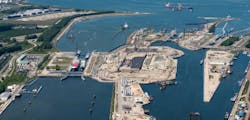Last Energy, Enea Group to develop Nuclear SMRs as Poland transitions to Carbon-Free
Small nuclear reactor manufacturer Last Energy and energy firm Enea Group signed an agreement to develop Last Energy’s 20-MW small modular reactors in Poland.
Deputy Prime Minister Jacek Sasin, Minister of State Assets, said, “We want nuclear energy – the traditional, large and state-built energy, as well as the micro-dimension – to be our future. Congratulations to Enea on finding a good and reliable partner who will help and guide them. This is the time that will decide whether we will win this race and Poland will retain its energy security.”
Enea supplies power to more than 2.7 million customers in Poland. The firm is focused on energy security as Enea transitions away from coal-fired power and its agreement with Last Energy is aligned with its Development Strategy aimed at carbon neutrality by 2050.
In order to achieve carbon neutrality in Poland by 2050, experts say that the rate of decarbonization has to increase by a factor of four every eight years. The small modular reactors will provide a zero-carbon solution and low-cost power and contribute to achieve the goal.
“An urgent investment in nuclear generation capacity will allow countries to quickly diversify their energy mix and solidify zero-carbon energy security for our future generations,” said Bret Kugelmass, CEO, Last Energy. “It’s incredibly encouraging to see this type of leadership from an organization like Enea, who shares our vision for affordable, clean and efficient baseload power. Scaling small modular nuclear power isn’t 10 years away. The technology is proven and ready, now. We are proud to bring our innovative delivery model together with Enea’s deep utilities expertise to usher in a new era of energy independence for Poland.”
For customers like Enea, Last Energy provides design, construction, financing, service and maintenance of installations, fuel supply, waste collection and decommissioning. Its power plant leverages a pressurized water reactor and fully modular plant design.
“With Last Energy, we will gain access to modern, scalable and, most importantly, emission-free electricity generation technology,” said Pawel Majewski, CEO, Enea. “Enea Group will be able to use the small modular reactor technology to build its own production capacity, and also to offer solutions for the industry and for Poland. Commercialization of SMR solutions will have a positive impact on energy security, the environment, and the competitiveness of the Polish economy. Enea's entry into the market of small, modular nuclear reactors will allow for the development of new business lines in the future.”
Last Energy is also in talks with commercial energy partners, regulators and governments in Latin America, Asia and Europe.





